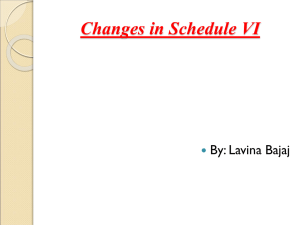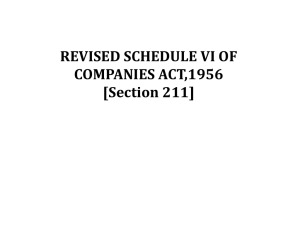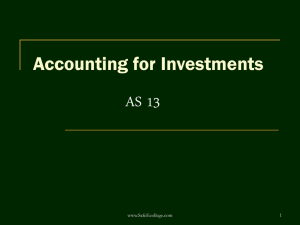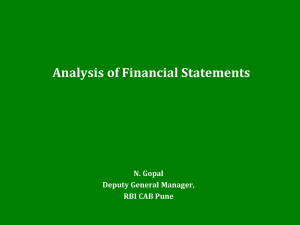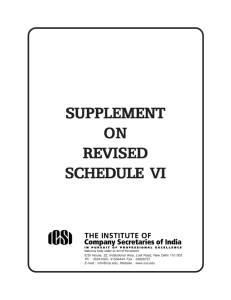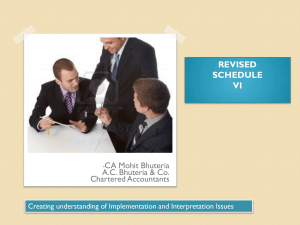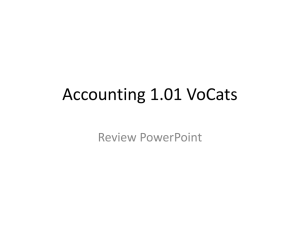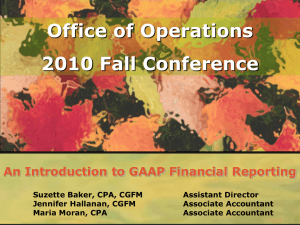Revised Schedule VI PPT
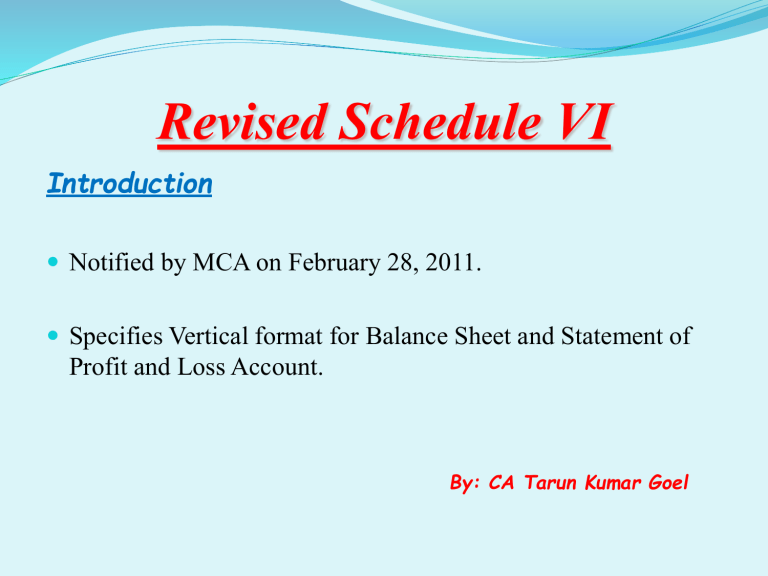
Revised Schedule VI
Introduction
Notified by MCA on February 28, 2011.
Specifies Vertical format for Balance Sheet and Statement of
Profit and Loss Account.
By: CA Tarun Kumar Goel
Applicability
Applicable for the year commencing on or after April 1, 2011.
The requirements does not apply to Banking and Insurance companies.
Applicable to companies engaged in generation or supply of electricity as no format is prescribed under Electricity Act,
2003 or rules thereto.
Applicability contd/-
Interim financial reporting as per AS 25 up to March 31, 2012:
Presents complete set of financial statement: Revised Schedule VI
Presents condensed financial statement: Old Schedule VI
Companies listed under listing agreement with SEBI:
For Half Yearly Results: Format specified in Annexure IX to listing agreement (Till its revised)
For Annual Results: Revised Schedule VI
Main Principles
Compliance with the Act and/or Accounting standards:
Requirements of the Act and/or Standards will override the related requirement of Schedule VI
Disclosures as required by Accounting Standards:
Additional disclosure specified in the Accounting standards shall be made in the notes to accounts or by way of additional statements unless required to be disclosed on the face of the Financial Statements.
Main Principles Contd/-
All items of Assets and Liabilities to be bifurcated between current and non-current portions for presentation.
Information in Schedule to Balance Sheet and Statement of
Profit and Loss Account shall be furnished as a part of Notes to
Accounts.
The terms used in Revised Schedule will carry the meaning as defined in by applicable Accounting Standards. Ex: Related parties, associates etc.
Main Principles Contd/-
Rounding off rules (where opted for) based on turnover
Where turnover up to Rs. 100 crores.- Hundreds, thousands, lakhs or millions or decimal thereof.
Where turnover exceeds Rs. 100 crores- lakhs, millions or crores or decimal thereof.
Once a unit of measurement is used, it should be used uniformly in the
Financial Statement.
Main Principles Contd/-
Only vertical format of Balance sheet and Statement of Profit and loss account are specified.
Title of Balance Sheet:
Liability Side
Changed from
Sources of Funds
To Equity and
Liabilities
Asset Side
Changed from
Application of Funds
To Assets
Depiction of Balance Sheet
EQUITY AND LIABILITIES
Shareholder’s Funds
Share capital
Reserves and Surplus
Money received against share warrants
Share application money pending allotment
Non-current liabilities
Long-term borrowings
Deferred tax liabilities (Net)
Other long term liabilities
Long-term provisions
Current liabilities
Short-term borrowings
Trade payables
Other current liabilities
Shot-term provisions
Depiction of Balance Sheet contd/-
ASSETS
Non-current assets
Fixed assets
Tangible assets
Intangible assets
Capital work-in-progress
Intangible assets under development
Non-current investments
Deferred tax assets (Net)
Long-term loans and advances
Other non-current assets
Current assets
Current investments
Inventories
Trade receivables
Cash and Bank Balance
Short-term loans and advances
Other current assets
Depiction of Statement of Profit and
Loss
I.
Revenue from operations
II.
Other Income
III.
Total Revenue (I-II)
IV.
Expenses:
Cost of materials consumed
Purchases of Stock-in-trade
Changes in inventories of finished goods, work in progress and Stock-intrade
Employee benefit expenses
Finance cost
Depreciation and amortization expenses
Other expenses
V.
Profit before exceptional and extraordinary items and tax (III-IV)
VI.
Exceptional items
VII.
Profit before extraordinary items and tax (V-VI)
VIII.
Extraordinary items
IX.
Profit before tax (VII-VIII)
Depiction of Statement of Profit and
Loss contd/-
X.
Tax expense:
Current tax
Deferred tax
XI.
Profit/(Loss) for the period from continuing operations (IX-X)
XII.
Profit/(Loss) from discontinuing operations
XIII.
Tax expense from discontinuing operations
XIV.
Profit/(Loss) from discontinuing operations after tax (XII-XIII)
XV.
Profit/(Loss) for the period (XI+XIV)
XVI.
Earning per equity share:
Basic
Diluted
Criteria for classifying Current Liability/
Asset:
It is expected to be settled in the company’s normal operating cycle.
It is held primarily for the purpose of being traded.
It is due to be settled within twelve months after the reporting date; or
The company does not have an unconditional right to defer settlement of the liability/asset for at least twelve months after the reporting date.
Other than that all should be classified as Non Current
Liabilities/Assets
Major changes related to Balance Sheet items:
New Line Items - Liabilities:
Money received against Share Warrants
Share Application Money pending allotment
Trade Payables
Separate headings for classifying Non-current and
Current Liabilities.
New Line Items - Assets:
Intangible Assets under development
Trade Receivables
Separate headings for classifying Non-current and
Current Assets.
Cash and cash equivalents.
New Disclosures in Share Capital:
A reconciliation of the number of shares outstanding at the beginning and at the end of the reporting period
Number of shares held by each shareholder holding more than 5% shares in the company as on balance sheet date.
For the period of five years immediately preceding the balance sheet date:
aggregate number of shares allotted as fully paid up:
pursuant to contract(s) without receiving payment being received in cash
by way of bonus share.
Aggregate number and class of shares bought back
Major changes related to balance sheet items
Reserves and Surplus:
Surplus i.e. balance in Statement of Profit and Loss disclosing allocations and appropriations such as dividend, bonus shares and transfer to/from reserves etc.
Debit balance of P&L A/c to be shown as a negative figure under the head ‘Surplus’
Major changes related to balance sheet items
Share application money pending allotment
Application money not exceeding the capital offered for issuance and to the extend not refundable shall be shown separately on the face of the Balance Sheet.
The amount in excess of subscription or if the requirements of minimum subscription are not met will be shown under the head “Other current liabilities”.
Major changes related to balance sheet items
Non-current and current liabilites:
Separate disclosure for Long term borrowings and short term borrowings under non- current and current liabilities.
Loans and advances from subsidiaries has been replaced by Loans and advances from related parties.
Period and amount of continuing default as on the balance sheet date in repayment of loans and interest, shall be specified separately in each case.
Current maturities of non-current liability due within 12 months from the Balance Sheet date shall be re classified as current liabilities.
Bifurcation of Long and Short term provision as noncurrent and current liabilities.
Major changes related to balance sheet items
Other current liabilities:
Share Application Money:
Application money received for allotment of securities and due for refund and interest accrued thereon.
The period for which the share application money has been pending beyond the period for allotment as mentioned in the document inviting application for shares along with the reason for such share application money being pending shall be disclosed.
Trade Payable:
Classified as trade payable if ,it is in respect of the due on account of goods purchased or services rendered in normal course of business.
Separate disclosure for MSME not required on the face of Balance Sheet. However, same shall be given in
Notes to Accounts.
Major changes related to balance sheet items
Fixed Assets:
Assets under lease shall be separately specified for each class of assets
Accumulated depreciation shall be shown as a part of referring note to fixed assets and, not on the face of
Balance Sheet.
Intangible asset under development shall be disclosed separately.
Capital advances shall be disclosed under Non-current
Assets under the sub heading of Loans and Advances irrespective of the time when assets are expected to be received.
Major changes related to balance sheet items
Non-current Investments:
Under each classification, details shall be given of names of the bodies corporate, indicating separately whether such bodies are i.
Subsidiaries, ii.
Associates, iii.
Joint ventures, or iv.
Controlled special purpose entities (Term not yet defined under the Act, Standards or rules)
Investments carried at other than cost should be separately stated specifying the basis of valuing them.
Major changes related to balance sheet items
Long term Loans and Advances
It shall include :
Capital Advances
Security deposits
Loans and Advances to Related Parties .
Other Loans and advances (Specify nature).
Separate disclosure no longer required for:
Due from companies under the same management within the meaning of Section 370 (1B).
Maximum amount due by directors and other officers of the company at any time during the year .
Major changes related to balance sheet items
Inventories:
Goods-in-transit shall be disclosed under the relevant sub-head of inventories
Separate disclosure for Stock-in-trade held for trading purpose.
Trade receivables:
Defined as dues arising only from goods sold or services rendered in the normal course of business.
Aggregate amount of Trade receivables outstanding for a period exceeding six months from the date they are due for payment should be separately disclosed.
Major changes related to balance sheet items
Cash and Bank Balance
Cash and Cash Equivalents :
Shall carry the same meaning as defined under AS-3,
Cash flow statements.
Bank deposits with more the 12 months maturity shall be disclosed separately under the same heading.
Other Bank Balances:
Balance with banks held as margin money or security against borrowings etc. which doesn’t qualify as cash and cash equivalents as per AS-3 shall be disclosed under this head.
Major changes related to balance sheet items
Miscellaneous Expenditure (to the extend not written off or adjusted:
No separate line item for such expenses.
Such expenses can be disclosed as “Unamortized
Expenses” under the head Non-current or Current assets depending on whether the amount will be amortized in the next 12 months or thereafter.
Major changes related to balance sheet items
Contingent Liabilities :
The amount of dividends proposed to be distributed to equity and preference shareholders for the period and the related amount per share shall be disclosed separately.
Proposed dividend is not to be provided for, in the financial statements.
Major changes related to balance sheet items
Major highlights of Statement of
Profit and Loss
Vertical Format specified in new Schedule.
Exceptional and extraordinary items need to be disclosed separately on the face of the Statement of Profit and Loss. The details of the same ,as also of any prior period items should be disclosed in the notes
Profit / loss before and after tax from discontinuing operations and the tax expense from discontinuing operations need to be disclosed separately on the face of the Statement of Profit and
Loss.
Major highlights of Statement of Profit and Loss
Where company collects indirect taxes like VAT etc. as intermediary, revenue should be presented net of taxes.
Employee Benefits expense should be disclosed separately as:
Salaries and wages
Contribution to provident and other funds
Expense on ESOP and ESPP
Staff welfare expenses
Major highlights of Statement of Profit and Loss
Payments to auditor ( in different capacities shall be
disclosed separately as):
Auditor
For taxation matters
For company law matters
For management services
For other services
For reimbursement of expenses
Finance cost shall be classified as interest expense, other borrowing costs & Gain / Loss on foreign currency transaction & translation
Major highlights of Statement of Profit and Loss
Any item of income or expenditure which exceeds one percent of the revenue from operations or Rs. 1,00,000 whichever is higher should be disclosed separately.
Broad heads shall be decided taking into account the concept of materiality and presentation of true and fair view of financial statements.
Major highlights of Statement of Profit and Loss
Additional Disclosures
Disclosures no longer required:
Commission paid to sole selling agents.
Payments provided or made to the directors (Including MD and manager) on account of managerial remuneration, allowances, commission, perquisites, benefits, pension, gratuity etc.
In case of manufacturing companies:
The licensed capacity
The installed capacity
The actual production.
Major highlights of Statement of Profit and Loss
Comparison between the Old and Revised
Schedule VI
Particulars
Authority
Form of Balance
Sheet
Form of Profit and Loss Account
Headings in
Balance Sheet
Profit and Loss
Appropriation
Account
Old Schedule VI Revised Schedule VI
Provisions of Schedule VI will prevail over
Accounting Standards
Provisions of Accounting
Standards will prevail over
Schedule VI
Both horizontal and vertical form were allowed
No format specified for
Profit and Loss Account
“Sources of funds” and
“Application of funds”
Opening surplus, proposed dividend and transfer to/ from reserves were shown in Profit and
Loss Appropriation
Account
Only vertical form of Balance
Sheet has been specified in the revised Schedule VI
Form of Profit and Loss
Account specified under Part
II
“Equities and Liabilities” and
“Assets”
Transfer from/ to reserves to be shown under the heading
Reserves & Surplus only. No requirement of separate Profit and Loss Appropriation
Account.
Comparison contd/-
Particulars
Proposed
Dividend
Quantitative
Details
Old Schedule VI
Proposed Dividend required to be provided for
Revised Schedule VI
Proposed Dividend to be disclosed in notes
Quantitative details of
Raw materials, purchases, stocks and turnover to be given for each class of goods. Also licensed and installed capacity and production quantity to be given for manufacturing companies
No quantitative details required. Limited requirements for disclosure for CIF and FOB values etc.
Comparison contd/-
Particulars
Share Capital
Old Schedule VI Revised Schedule VI
No requirement to disclose separately bonus shares issued during last 5 years.
In addition to the disclosure requirements of old Schedule
VI following additional disclosures are also required
Also no requirement for details of shareholders holding more than 5% of shares
•Number of bonus shares/ shares allotted without payment being received in cash/ shares bought back during last 5 years
•Names and number of shares held by shareholders holding more than 5 percent of total shares
Comparison contd/-
Particulars
Net Working
Capital
Fixed Assets
Old Schedule VI
Current assets &
Liabilities are shown together under application of funds. The net working capital appears on balance sheet.
There was no bifurcation required in to tangible & intangible assets.
Capital advances used to be shown under the Head
Capital Work in Progress under Fixed Assets
Revised Schedule VI
Assets & Liabilities are to be bifurcated in to current &
Non-current and to be shown separately. Hence, net working capital will not be appearing in Balance sheet.
Fixed assets to be shown under non-current assets and have to be bifurcated in to
Tangible & intangible assets.
Capital advances to be shown under the head ‘Long term
Loans and Advances
Comparison contd/-
Particulars
Borrowings
Deposits
Old Schedule VI
Short term & long term borrowings are grouped together under the head
Loan funds sub-head
Secured / Unsecured
Revised Schedule VI
Long term borrowings to be shown under non-current liabilities and short term borrowings to be shown under current liabilities with separate disclosure of secured
/ unsecured loans.
Lease deposits are part of loans & advances
Period and amount of continuing default as on the balance sheet date in repayment of loans and interest to be separately specified.
Lease deposits to be disclosed as long term loans & advances under the head non-current assets
Comparison contd/-
Particulars
Deferred Tax
Assets /
Liabilities
Old Schedule VI
Deferred Tax assets / liabilities to be disclosed separately on the face of
Balance Sheet.
Revised Schedule VI
Deferred Tax assets / liabilities to be disclosed under non-current assets / liabilities as the case may be.
Sundry Debtors Debtors outstanding for more than six months from invoice date to be shown separately
Profit & Loss
(Debit Balance)
P&L debit balance to be separately disclosed in the
Balance Sheet.
Debtors outstanding for more than six months from the date they became due to be shown separately.
Debit balance of Profit and
Loss Account to be shown as negative figure under the head
Surplus. Therefore, Reserve &
Surplus can have a negative balance
Comparison contd/-
Particulars
Other current liabilities
Separate line item Disclosure criteria
Old Schedule VI
No specific mention for separate disclosure of
Current maturities of long term debt
Revised Schedule VI
Current maturities of long term debt to be disclosed under other current liabilities.
Current maturities of finance lease obligation to be disclosed.
No specific mention for separate disclosure of
Current maturities of finance lease obligation
Any item under which expense exceeds one per cent of the total revenue of the company or Rs.
5,000 which ever is higher; shall be disclosed separately
Any item of income / expense which exceeds one per cent of the revenue from operations or Rs. 1,00,000, which ever is higher; to be disclosed separately
Comparison contd/-
Particulars
Purchases
TDS amount on
Interest, royalty received
Old Schedule VI
The purchase made and the opening & closing stock, giving break up in respect of each class of goods traded in by the company and indicating the quantities thereof.
Revised Schedule VI
Goods traded in by the company to be disclosed in broad heads in notes.
Disclosure of quantitative details of goods is diluted.
Goods-in-transit to be separately disclosed
TDS amount was required to be shown for Interest income etc.
No requirement of disclosing
TDS amounts separately
Managerial
Remuneration and Commission
Payment to directors and detailed calculation under section 198 was required to be disclosed
No disclosure requirements for Managerial Remuneration
Comparison contd/-
Particulars Old Schedule VI
ESOP expenses No requirement to show separately as part of
Employee Benefits expense
Revised Schedule VI
Expense on Employee Stock
Option Scheme (ESOP) and
Employee Stock Purchase
Plan (ESPP) to be shown separately as part of
Employee Benefits expense
Part III-
Interpretation
Part IV- Balance
Sheet Abstract
Terms provision, reserve, capital reserve, quoted investment etc. were defined
Details of company registration number, capital raised, Balance
Sheet details, products etc. were required to be attached with financials
No such specific definitions.
No such requirement.
Issues and complexities:
Reclassification of Previous Year/Period figures.
Computation of Net-working capital for finance.
Ageing for receivables to be calculated from due date of payment.
Substantial efforts required by companies to recast and auditors to audit previous reporting period’s figures.
Challenges in getting information of shareholders holding more than 5% of share capital from Depository
Participants, GDR / ADR custodians.
Issues and complexities contd/-
Clarification required for nature and definition of
“Controlled Special Purpose Entity”.
Ageing based on due date of invoice will require significant systemic changes.
